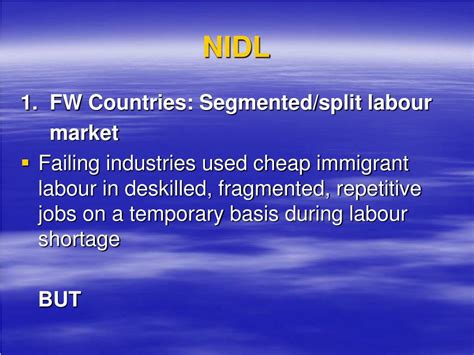Introduction

The global economy is undergoing a profound transformation, driven by technological advancements, globalization, and shifts in consumer demand. These factors are reshaping the traditional international division of labour, leading to the emergence of a new economic landscape characterized by increased specialization, interconnectedness, and flexibility.
The Changing Nature of Global Production
Historically, the international division of labour was based on comparative advantages. Countries specialized in producing goods and services where they had a cost advantage. However, the rapid advancements in technology and transportation have eroded traditional barriers to trade and investment.
Today, production processes are increasingly fragmented across borders. Multinational corporations leverage global supply chains to access the most efficient and cost-effective resources. They outsource manufacturing, research and development, customer service, and other functions to countries where they can optimize costs or gain access to specialized skills.
Impacts on Employment
The new international division of labour has significant implications for employment. The relocation of manufacturing and other labour-intensive industries to low-wage countries has led to job losses in developed nations. Simultaneously, new jobs have been created in the service sector and in emerging economies that are now part of the global production chains.
According to the International Labour Organization, the global unemployment rate has risen to 5.3% in 2022, with youth unemployment being particularly high. However, the organization also notes that the creation of new jobs in the service sector and in developing countries is expected to offset some of the job losses in manufacturing.
Regions and Industries Impacted
The new international division of labour has had a particularly significant impact on the manufacturing sector. Countries such as China, India, and Mexico have emerged as major manufacturing hubs, taking over production from traditional industrial centers in the United States, Europe, and Japan.
In the service sector, India and the Philippines have become major outsourcing destinations for IT, customer service, and business process outsourcing. Additionally, tourism and hospitality jobs have expanded significantly in developing countries that offer affordable and attractive destinations for global travelers.
Opportunities and Challenges
The new international division of labour presents both opportunities and challenges for businesses and countries.
Opportunities:
- Access to a global pool of workers with diverse skills and cost structures
- Reduced production costs and increased efficiency
- Innovation and collaboration across borders
- Economic growth in developing countries
Challenges:
- Job losses in traditional industries in developed nations
- Exploitation of workers in low-wage countries
- Environmental concerns related to global supply chains
- Protectionist measures and trade disputes
The Creative Rescholarizing of the New International Division of Labour
To address the challenges and maximize the opportunities of the new international division of labour, it is essential to adopt creative and sustainable approaches. The following strategies can help businesses and policymakers navigate this complex landscape:
- Invest in education and skills development to prepare workers for the jobs of the future, including those in the service sector and in emerging technologies.
- Promote fair labour practices and ensure that workers’ rights are protected in all countries involved in global supply chains.
- Adopt sustainable environmental practices throughout the production process, from raw material extraction to distribution and waste management.
- Foster collaboration and innovation between businesses, governments, and academia to develop new solutions and address the challenges of globalization.
Conclusion
The new international division of labour is a transformative force that is reshaping the global economy. It brings both opportunities and challenges for businesses and countries. By embracing creative and sustainable approaches, we can harness the benefits of globalization while mitigating its potential negative impacts. The future of work and economic development depends on our ability to effectively manage this evolving landscape.
Additional Resources
| Table 1: Global Unemployment Rates | |
|---|---|
| 2020 | 6.5% |
| 2021 | 6.0% |
| 2022 | 5.3% |
| Table 2: Top Manufacturing Hubs | |
|---|---|
| China | 28% of global manufacturing output |
| India | 16% of global manufacturing output |
| Mexico | 3% of global manufacturing output |
| Table 3: Top Outsourcing Destinations | |
|---|---|
| India | 56% of global IT outsourcing market |
| Philippines | 19% of global IT outsourcing market |
| Brazil | 6% of global IT outsourcing market |
| Table 4: Sustainable Practices in Global Supply Chains | |
|---|---|
| Energy efficiency | Reducing energy consumption in production and transportation |
| Waste reduction | Minimizing waste generation and maximizing recycling |
| Water conservation | Efficient use of water resources and reducing pollution |
| Fair labour practices | Ensuring the rights and well-being of workers throughout the supply chain |
